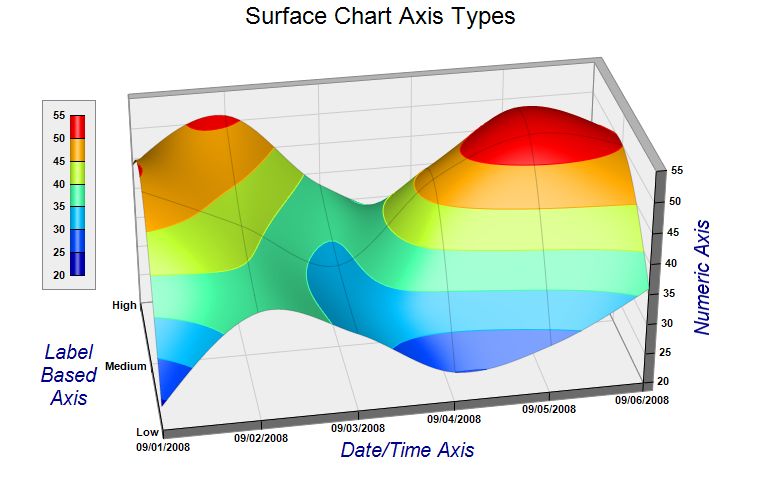require("chartdirector")
class SurfaceaxisController < ApplicationController
def index()
@title = "Surface Chart Axis Types"
@ctrl_file = File.expand_path(__FILE__)
@noOfCharts = 1
render :template => "templates/chartview"
end
#
# Render and deliver the chart
#
def getchart()
# The x and y coordinates of the grid
dataX = [Time.mktime(2008, 9, 1), Time.mktime(2008, 9, 2), Time.mktime(2008, 9, 3),
Time.mktime(2008, 9, 4), Time.mktime(2008, 9, 5), Time.mktime(2008, 9, 6)]
dataY = ["Low", "Medium", "High"]
# The data series
lowData = [24, 38, 33, 25, 28, 36]
mediumData = [49, 42, 34, 47, 53, 50]
highData = [44, 51, 38, 33, 47, 42]
# Create a SurfaceChart object of size 760 x 500 pixels
c = ChartDirector::SurfaceChart.new(760, 500)
# Add a title to the chart using 18 points Arial font
c.addTitle("Surface Chart Axis Types", "arial.ttf", 18)
# Set the center of the plot region at (385, 240), and set width x depth x height to 480 x
# 240 x 240 pixels
c.setPlotRegion(385, 240, 480, 240, 240)
# Set the elevation and rotation angles to 30 and -10 degrees
c.setViewAngle(30, -10)
# Set the data to use to plot the chart. As the y-data are text strings (enumerated), we
# will use an empty array for the y-coordinates. For the z data series, they are just the
# concatenation of the individual data series.
c.setData(dataX, nil, ChartDirector::ArrayMath.new(lowData).insert(mediumData).insert(
highData).result())
# Set the y-axis labels
c.yAxis().setLabels(dataY)
# Set x-axis tick density to 75 pixels. ChartDirector auto-scaling will use this as the
# guideline when putting ticks on the x-axis.
c.xAxis().setTickDensity(75)
# Spline interpolate data to a 80 x 40 grid for a smooth surface
c.setInterpolation(80, 40)
# Set surface grid lines to semi-transparent black (cc000000).
c.setSurfaceAxisGrid(0xcc000000)
# Set contour lines to the same color as the fill color at the contour level
c.setContourColor(ChartDirector::SameAsMainColor)
# Add a color axis (the legend) in which the top right corner is anchored at (95, 100). Set
# the length to 160 pixels and the labels on the left side.
cAxis = c.setColorAxis(95, 100, ChartDirector::TopRight, 160, ChartDirector::Left)
# Add a bounding box with light grey (eeeeee) background and grey (888888) border.
cAxis.setBoundingBox(0xeeeeee, 0x888888)
# Set label style to Arial bold for all axes
c.xAxis().setLabelStyle("arialbd.ttf")
c.yAxis().setLabelStyle("arialbd.ttf")
c.zAxis().setLabelStyle("arialbd.ttf")
c.colorAxis().setLabelStyle("arialbd.ttf")
# Set the x, y and z axis titles using deep blue (000088) 15 points Arial font
c.xAxis().setTitle("Date/Time Axis", "ariali.ttf", 15, 0x000088)
c.yAxis().setTitle("Label\nBased\nAxis", "ariali.ttf", 15, 0x000088)
c.zAxis().setTitle("Numeric Axis", "ariali.ttf", 15, 0x000088)
# Output the chart
send_data(c.makeChart2(ChartDirector::JPG), :type => "image/jpeg", :disposition => "inline")
end
end |
